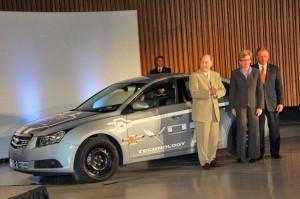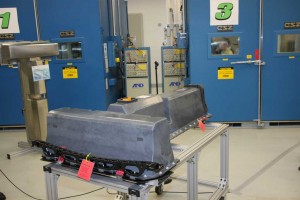
GM CEO with Chevy Volt "mule" during dedication of the automaker's new battery lab. Governor Jennifer Granholm and product engineering chief Jim Queen are to Henderson's left.
Calling it “the lifeblood of our future,” General Motors CEO Fritz Henderson officially opened the automaker’s new battery lab, at the GM Technical Center, this morning.
The facility is designed to help develop the next-generation lithium-ion batteries that the automaker hopes to use in future products, such as the Chevrolet Volt extended-range-electric vehicle, or E-REV, which it plans to put on the market around November 2010.
The lab was opened at least five months ahead of schedule, GM officials noted, during a dedication ceremony and subsequent tour, and should help ensure that the Volt makes it to market on time.
“Electrically-driven vehicles provide the best alternative for a sustainable future,” declared Jim Queen, the bankrupt automaker’s top engineer. The challenge, he and other company officials later added, is making sure that GM can come up with batteries that meet public expectation for range, cost and durability.
That’s the role of the new battery lab, which is housed on the sprawling Tech Center campus, in the Detroit suburb of Warren, Michigan. It replaces a smaller and less technically sophisticated facility only a quarter of its size. The new lab measures 33,000 square feet and can put more than 200 battery packs through their paces at a time, on test stands and thermal chambers designed to simulate the worst possible conditions a vehicle like the Volt might face.
This has resulted in the drastic reduction in development time and will significant speed up time to market,” asserted Queen.
In all, the lab can draw as much as 6 megawatts from the electric grid-enough for 1500 typical homes – though about 90 percent of that energy can also be pumped back out, as much of the testing involves seeing how well the batteries can store and then release energy.

Chevy Volt's lithium-ion battery pack stores as much energy as the old lead-acid GM EV1 battery, but at a third the weight.
GM plans to reduce its dependence on the grid through the use of both wind generators and solar cells, officials noted. They’ve also made extensive efforts to reduce the lab’s overall energy consumption through such things as LED lighting. The floors of the facility are made of recycled rubber, meanwhile, and the ceiling uses mostly recycled aluminum panels.
Though testing will be underway on a 24/7 basis, the new battery lab will be a lean, “lights-out operation,” according to Doug Drach, the facility’s lead engineer. It will only be manned on one shift, and even then, there will be no more than 27 staffers, Drach noted, including interns and students assigned to the center. A software package, dubbed Lab Minder, will be used to constantly monitor operations, down to the individual battery. If necessary, the program can dial four staff members normally on call. Webcams, placed throughout the lab, can be accessed by authorized personnel, for an instant look at what’s happening in real-time.
Test drivers have already clocked tens of thousands of miles in Volt “mules,” vehicles like the Chevrolet Cruse, that have had their conventional powertrain systems replaced by prototype Volt drivelines. That’s given GM management confidence the E-REV – or as some prefer, the plug-in hybrid – will be able to meet market expectations. But with the Volt battery still an unknown, the new lab will accelerate the testing phase by simulating conditions faced by those mules — or worse.
 One of the most useful tools at the lab is the thermal chamber – 40 in all. They can expose a Volt battery, or an entire drivetrain, to temperature and humidity extremes as diverse as what a production vehicle might face in a Minnesota winter or a Mojave desert summer.
One of the most useful tools at the lab is the thermal chamber – 40 in all. They can expose a Volt battery, or an entire drivetrain, to temperature and humidity extremes as diverse as what a production vehicle might face in a Minnesota winter or a Mojave desert summer.
“I’m a development guy,” said engineer Lance Turner. “I’m going to push beyond those specs to test it.”

To ensure they can survive real-world conditions, Volt battery packs and driveline systems will under freezing cold and desert heat in thermal chambers like this one.
After examining more than 100 different battery designs and actually testing about 40, GM settled on a chemistry developed by the South Korean maker LG Chem. The firm will produce the basic, individual cells in Asia and ship them to the U.S. for assembly into packs at a new facility GM plans to open later this year.
The first, hand-built Volt prototypes recently went into testing. So-called “pre-production volume build” will launch next Summer. And barring a last-minute setback in testing at the battery lab, the first customers should drive home in a Volt before the end of 2010.
